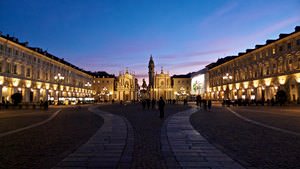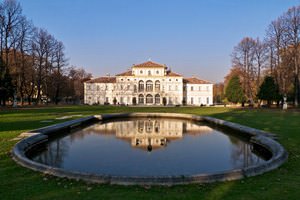 It’s hard to imagine Turin, and Italy in general, without its famous architectural landmarks. Mole Antonelliana, Palazzo Carignano, Turin Cathedral, Porta Palatina, Castello del Valentino, Stadio Olimpico, Villa della Regina, and Piazza della Consolata have shaped the historical and architectural look of Turin. Let’s take a closer look at these landmarks from an unusual perspective – simply fly over the main sights! The supporting video includes a virtual tour around the above mentioned architectural landmarks of Turin in HD format. Below, we will add the most exciting historical facts regarding every place of interest. The overview map of all iconic landmarks of Turin can be found at the bottom of the webpage.
It’s hard to imagine Turin, and Italy in general, without its famous architectural landmarks. Mole Antonelliana, Palazzo Carignano, Turin Cathedral, Porta Palatina, Castello del Valentino, Stadio Olimpico, Villa della Regina, and Piazza della Consolata have shaped the historical and architectural look of Turin. Let’s take a closer look at these landmarks from an unusual perspective – simply fly over the main sights! The supporting video includes a virtual tour around the above mentioned architectural landmarks of Turin in HD format. Below, we will add the most exciting historical facts regarding every place of interest. The overview map of all iconic landmarks of Turin can be found at the bottom of the webpage.
Mole Antonelliana, Torino
Location on the map:  Facts:
Facts:
» The Mole Antonelliana has been the highest building in Turin and even in France until 2011. It was designed by architect Alessandro Antonelli. » Originally, it served as a synagogue for the Jewish community in 1863. It was planned that the building would be 66 m high. Antonelli was obsessed with high buildings. As a result, the tower is 167.5 m high.
» The 90-year-old architect did not manage to complete the project and see his creation. The building was finished in 1889 by city authorities.
» The first museum opened here in 1908 was the Museum of the Risorgimento. Its exhibits are dedicated to the Italian liberation movement.
» During the hurricane in 1953, the 47-meter Mole Antonelliana fell. It was restored in 1961.
» In 2000, the National Museum of Cinema was opened. The entire space of the museum is galleries and exhibitions. Interestingly, the cable lift is situated in the center of the tower, so when it takes you up, you can observe museum exhibits.
» The Mole Antonelliana is the pride not only of the locals, but also of all Italians. It is even stamped on coins. It was also the symbol of the Winter Olympics in Turin in 2006.
Palazzo Carignano, Torino
Location on the map:  Facts:
Facts:
» The Palazzo Carignano is a Turkish residence of the Carignano branch of the House of Savoy. » The Palazzo Carignano is famous for its luxurious concavo-convex facade constructed by architect Francesco Borromini.
» The palace was built in 1679 by the project of priest Guarino Guarini.
» The fanciful curved main staircase and the double dome above the main entrance are some of the boldest and most constructive features of the construction.
» The Palazzo Carignano is designed in the style of Italian baroque.
» In 1820, the first King of Italy, Victor Emmanuel II was born in the Palazzo Carignano. In honor of this important event, the Museum of the Risorgimento was opened in 1938 in the palace.
» Like other residences of the House of Savoy, the Palazzo Carignano is under the protection of UNESCO as a World Heritage Site.
» The palace has two absolutely different facades. One of them that is unplastered and made of bricks faces Piazza Carignano. The other faces Piazza Carlo Alberto.
» Today, the Palazzo Carignano has 27 halls of the National Museum of the Risorgimento.
Turin Cathedral, Torino
Location on the map:  Facts:
Facts:
» Turin Cathedral is one of the main religious sites in the country. It is also known as the Cathedral of Saint John the Baptist. » Turin Cathedral was built in the period between 1491 and 1498.
» The famous Chapel of the Holy Shroud was added to the Cathedral of Saint John the Baptist in 1668-1694.
» In the chapel of Turin Cathedral, tourists can always see the replica of the shroud.
» The original shroud where Christ’s face and body was reflected is displayed in Turin Cathedral once a quarter of a century.
» The Cathedral of Saint John the Baptist is a bulwark of Catholicism.
» According to the architect’s idea, Turin Cathedral was built in the Renaissance style.
» The whitewashed facade and strict and clear lines of the cathedral are so ascetic and make the construction highly religious.
» Turin Cathedral is the only preserved building in the Renaissance style in the city.
Porta Palatina, Torino
Location on the map:  Facts:
Facts:
» The Palatine Gate that is also known as Porta Palatina is one of the most well-preserved ancient Roman gates in the world. It was designed and built in the 1st century BC. » The Palatine Gate was completely built of durable bricks.
» The Porta Palatine was constructed on a square foundation, which makes the gate lasting and stable.
» Two corner towers of the Palatine Gate are almost 30 m high. They are distinguished by 16 side edges.
» The central body of the construction is the interturrio. The gate is 20 m high and has two rows of windows. The lower row consists of arched windows and the upper one –of spandrel windows.
» The Palantine Gate has four entrances. The central one is used by vehicles and side entrances - pedestrians.
» Not far from the Porta Palatina, there is well-preserved part of a guard box built in the times of the Roman Empire. Today, you can see only its foundation.
» After the collapse of the Roman Empire, the Palatine Gate served as a fortified palace.
Castello del Valentino, Torino
Location on the map:  Facts:
Facts:
» The Castle of Valentino is one of the Residences of the Royal House of Savoy in Turin. » The castle is under the protection of UNESCO as a World Heritage Site.
» Originally, the Residence of the House of Savoy was built as a medieval fortified castle. The Castle of Valentino has the shape of a horseshoe that is quite typical for constructions of that time.
» The building was named after the nearby Church of St. Valentino.
» The castle was bought by Duke Emmanuel Philibert of Savoy who moved from Chambery to Turin.
» The Castello del Valentino acquired its current appearance only in the 17th century. In the 1600s, the construction was completely rebuilt in the French style upon the order of Princess Christine Marie of France who lived here.
» In the 19th century, the Castle of Valentino was abandoned. In 1860, it became the seat of the Architecture Faculty of the Polytechnic University and was restored.
» In 1900, the first Turin Motor Show was held in the castle.
» Then, a botanical garden was set up in the castle grounds.
Stadio Olimpico, Torino
Location on the map:  Facts:
Facts:
» The Stadio Olimpico was built in Turin in 1933. One year after, it hosted the international football championship. The stadium accommodated 65 000 spectators. » Originally, it was named Mussolini after the head of the country.
» The playing field is oval. There are also running tracks and equipment for track and field competitions. After the Second World War, the stadium was renamed. Players of Torino and Juventus clubs trained here.
» The stadium had been closed for some time. In 2006, it was reconstructed for the Olympics. Draughtsmen decided not to choose a particular architectural style.
» After the reconstruction, the stadium is round but it has right angles.
» The updated arena accommodates over 27 000 people. There are canopies over the stands but the playing field is still outdoor. The field is 105х68 m.
» At the stadium, the opening and closing ceremonies of the Winter Olympic Games took place. Here, music concerts are also held.
Villa della Regina, Torino
Facts: » The Villa della Regina was built in 1615 by the court architect and military engineer Ascanio Vitozzi on one of the Turin hills. It resembles a Roman villa.
» The construction was ordered by the Prince-Cardinal Maurice of Savoy for his wife Louise of Savoy. At that time, she was 14 years old. This is why the first name of the villa is Villa Ludovica.
» The members of the royal family lived in the villa at different times. Then, the residence was named “Villa of the Queen”.
» During the Second World War, the building was bombed. The restoration was completed only in 2006.
» The palace is designed in the original baroque style of the 17th century. Here, you can still see well-preserved Chinese lacquer wooden gilt cabinets.
» The complex also includes gardens with grottoes and fountains, galleries, and buildings decorated with paintings and frescoes from famous Italian artists and sculptors.
» In the rectangular courtyard, there is a castle. It is surrounded by terraces with vineyards.
» In 1997, the complex was declared the Residence of the House of Savoy and included in the list of UNESCO World Heritage Sites.
Piazza della Consolata, Torino
Facts: » The Piazza della Consolata was built in the 4th century AD at the site of the sanctuary of the Virgin of the Consolation. It is located in the north of Turin.
» The basilica received its name, Consolata, after St. Andrew.
» According to the famous legend, when the Piazza della Consolata was being built, the most revered icon Mother of God with Baby Jesus was kept here. The icon was lost under unexplained circumstances. It was found only in the 12th century. The legend says that the sacred thing was found by a blind boy who miraculously recovered his sight.
» Due to this legend, Turin attracts a lot of pilgrims. Exactly the increased number of visitors gave an impetus to the construction of the Piazza della Consolata.
» The modern building was finished in the 17th century.
» The basilica was constructed by the project of the best architect of that time Guarino Guarini.
» Over the years, the building had been reconstructed many times.
» It gained its present form only in 1860.
» The basilica is designed in the Neoclassic style.









